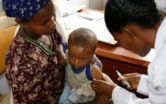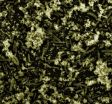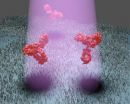(Press-News.org) At nearly 100 feet long and weighing as much as 170 tons, the blue whale is the largest creature on the planet, and by far the heaviest living thing ever seen on Earth. So there's no way it could have anything in common with the tiniest fish larvae, which measure millimeters in length and tip the scales at a fraction of a gram, right?
Not so fast, says L. Mahadevan, the Lola England de Valpine Professor of Applied Mathematics, of Organismic and Evolutionary Biology, and of Physics.
Using simple hydrodynamics, a team of researchers led by Mahadevan was able to show that a handful of principles govern how virtually every animal -- from the tiniest fish to birds to gigantic whales propel themselves though the water. The study is described in a September 14 paper in Nature Physics.
"What we wanted to investigate was how the speed of an organism changes as a function of how large it is, how quickly it moves and how much it moves," Mahadevan said. "To resolve that in detail, however, is very complex, because there is a great deal of differences in morphology and what parts of the body different creatures use to swim. The question is: Is there anything in common across all these organisms? The answer, we found, is yes."
In an effort to uncover those common principles, Mahadevan working with a postdoctoral fellow in his group , Mattia Gazzola, and a colleague Mederic Argentina from the University of Nice, began by trying to unpack the physics of how different creatures swim.
"The traditional approach to swimming phenomena is to take a certain specimen and accurately characterize it via experiments and/or simulations, and try to generalize from there, but it is very hard to strip out specific biological effects from general principles," Gazzola said. "We instead thought that while swimmers exhibit a huge diversity in shapes and kinematics, at the end of the day they all live in the same media, water.
"Therefore we thought that if a unifying mechanistic principle existed, it had to lie in the constraints that the flow environment poses to all its inhabitants," he continued. "And this is a purely physical problem, much easier to solve since it is not affected by biological vagaries. What I like about this paper is that in one line of algebra we derived a compact formula that accounts for 50 years of experiments. This is an example of how powerful minimal modeling can be."
"The basic relationship we wanted to understand was how the input variables – namely the size of the organism, the amount an organism moves and how quickly it moves – control the output variable, which is effectively the speed at which it moves," Mahadevan explained. "What we found is that there is a specific relationship, which can be described by in terms of a simple scaling law with two limits."
The first, which corresponds to creatures moving at intermediate speeds, describes situations where the bulk of the resistance is caused by skin friction, because water "sticks" to the organism's body. At faster speeds, Mahadevan said, the resistance organisms face largely comes from pressure that builds up in front of and around them, which is described by the second limit.
"While it wasn't a surprise that the resistance changed at organisms moved faster, the fact that those challenges could be so simply described was interesting and provocative, because we are talking about organisms that range in size from a few millimeters to the size of a blue whale," Mahadevan said.
Armed with those observations, Mahadevan and colleagues turned to a host of empirical observations that had been made over the past 50-plus years. When those data were plotted on a graph, the researchers found that the swimming speed of virtually every organism, from fish larvae to frogs to birds, amphibians and even whales, could be described by one of the two equations.
The same also held true, Mahadevan said, when Gazzola created complex computer models to solve the governing equations of fluid dynamics to describe how different organisms swim.
"What is particularly interesting is that all the organisms essentially reach the hydrodynamic limits of performance," he said. "Our simple theory, which doesn't distinguish in any detailed way between something like a blue whale and fish larvae, except in the parameters of how large you are, much you move and how quickly you move, can describe all this diversity. That suggests there are general principles at work here."
INFORMATION:
The science behind swimming
From whales to larvae, study finds common principles at work in swimming
2014-09-15
ELSE PRESS RELEASES FROM THIS DATE:
Brain Development in Schizophrenia Strays from the Normal Path
2014-09-15
Philadelphia, PA, September 15, 2014 – Schizophrenia is generally considered to be a disorder of brain development and it shares many risk factors, both genetic and environmental, with other neurodevelopmental disorders such as autism and intellectual disability.
The normal path for brain development is determined by the combined effects of a complex network of genes and a wide range of environmental factors.
However, longitudinal brain imaging studies in both healthy and patient populations are required in order to map the disturbances in brain structures as they emerge, ...
Sleep disorders widely undiagnosed in individuals with multiple sclerosis
2014-09-15
(SACRAMENTO, Calif.) —In what may be the largest study of sleep problems among individuals with multiple sclerosis (MS), researchers at UC Davis have found that widely undiagnosed sleep disorders may be at the root of the most common and disabling symptom of the disease: fatigue.
Conducted in over 2,300 individuals in Northern California with multiple sclerosis, the large, population-based study found that, overall, more than 70 percent of participants screened positive for one or more sleep disorders.
The research highlights the importance of diagnosing the root causes ...
How evolutionary principles could help save our world
2014-09-15
The age of the Anthropocene--the scientific name given to our current geologic age--is dominated by human impacts on our environment. A warming climate. Increased resistance of pathogens and pests. A swelling population. Coping with these modern global challenges requires application of what one might call a more-ancient principle: evolution.
That's the recommendation of a diverse group of researchers, in a paper published today in the online version of the journal Science. A majority of the nine authors on the paper have received funding from the National Science Foundation ...
Boosting armor for nuclear-waste eating microbes
2014-09-15
EAST LANSING, Mich. – A microbe developed to clean up nuclear waste and patented by a Michigan State University researcher has just been improved.
In earlier research, Gemma Reguera, MSU microbiologist, identified that Geobacter bacteria's tiny conductive hair-like appendages, or pili, did the yeoman's share of remediation. By increasing the strength of the pili nanowires, she improved their ability to clean up uranium and other toxic wastes.
In new research, published in the current issue of Applied and Environmental Microbiology, Reguera has added an additional layer ...
Selway complex and Johnson Bar fires in Idaho
2014-09-15
Two fires are seen burning in this satellite image taken by the Aqua satellite on September 11, 2014. The Selway complex of fires had been previously reported located 30 miles west of Darby, MT. It appears a new fire may have started again in this complex. Currently the size of the complex is 1,659 fires. The fire is mostly contained and there will be no additional reporting on this fire unless activity increases. It is, for the most part, contained.
The Johnson Bar fire started with a lightning strike on August 03, 2014. To date, 8,867 acres have been affected. ...
New glaucoma culprit is found
2014-09-15
Glaucoma, a leading cause of irreversible blindness, is associated with elevated pressure in the eye. This elevated pressure essentially is due to a plumbing problem. Fluid builds up in the eye, increasing pressure and eventually damaging the optic nerve. For nearly 150 years, researchers have been trying to understand what causes the blockage that prevents the eye from draining properly.
In a unique study of human ocular cells, a multi-institution research team led by a biomedical engineer at Northwestern University has found a new culprit. Glaucoma appears to be a consequence ...
Getting hot and wet in Vermont
2014-09-15
Here's your northern Vermont forecast for the rest of this century: annual precipitation will increase by between a third and half an inch per decade, while average temperatures will rise some five degrees Fahrenheit by midcentury. By late in the century, average temperatures will have spiked more than eight degrees. In July, by 2100, the City of Burlington will have at least ten additional days above ninety degrees. The growing season picks up 43 more days. Looking at ski conditions, expect annual snowfall at six major ski resorts to decline about fifty percent by century's ...
Mayo finds many liver transplant patients can avoid costly stay in ICU after surgery
2014-09-15
JACKSONVILLE, Fla., Sept. 12, 2014 — The liver transplant team at Mayo Clinic in Florida has found, based on 12 years of experience, that more than half of patients receiving a new liver can be "fast-tracked" to return to a surgical ward room following their transplant, bypassing a one- or two-day stay in the Intensive Care Unit (ICU).
In the September issue of the American Journal of Transplantation, the physicians and researchers have turned their knowledge of who can be safely fast-tracked into a scoring system that other transplant centers can also use — thus sparing ...
The shadow of a disease
2014-09-15
This news release is available in German.
In future, some diseases might be diagnosed earlier and treated more effectively. Researchers at the Max Planck Institute for the Science of Light in Erlangen have developed an optical method that makes individual proteins, such as the proteins characteristic of some cancers, visible. Other methods that achieve this only work if the target biomolecules have first been labelled with fluorescent tags; In general, however, that approach is difficult or even impossible. By contrast, with their method, coined iSCAT, the researchers ...
Unemployment for doctoral scientists and engineers below national average in 2013
2014-09-15
A new National Science Foundation (NSF) report says the 2013 unemployment rate for individuals with research doctoral degrees in science, engineering and health (SEH) fields was one-third the rate for the general population aged 25 and older--2.1 percent versus 6.3 percent.
According to the report, an estimated 837,900 individuals in the United States held SEH research doctoral degrees in 2013, and nearly 735,900 of them were in the labor force; this includes those employed full time or part time and unemployed individuals actively seeking work.
Statistics show that ...
LAST 30 PRESS RELEASES:
New software sheds light on cancer’s hidden genetic networks
UT Health San Antonio awarded $3 million in CPRIT grants to bolster cancer research and prevention efforts in South Texas
Third symposium spotlights global challenge of new contaminants in China’s fight against pollution
From straw to soil harmony: International team reveals how biochar supercharges carbon-smart farming
Myeloma: How AI is redrawing the map of cancer care
Manhattan E. Charurat, Ph.D., MHS invested as the Homer and Martha Gudelsky Distinguished Professor in Medicine at the University of Maryland School of Medicine
Insilico Medicine’s Pharma.AI Q4 Winter Launch Recap: Revolutionizing drug discovery with cutting-edge AI innovations, accelerating the path to pharmaceutical superintelligence
Nanoplastics have diet-dependent impacts on digestive system health
Brain neuron death occurs throughout life and increases with age, a natural human protein drug may halt neuron death in Alzheimer’s disease
SPIE and CLP announce the recipients of the 2025 Advanced Photonics Young Innovator Award
Lessons from the Caldor Fire’s Christmas Valley ‘Miracle’
Ant societies rose by trading individual protection for collective power
Research reveals how ancient viral DNA shapes early embryonic development
A molecular gatekeeper that controls protein synthesis
New ‘cloaking device’ concept to shield sensitive tech from magnetic fields
Researchers show impact of mountain building and climate change on alpine biodiversity
Study models the transition from Neanderthals to modern humans in Europe
University of Phoenix College of Doctoral Studies releases white paper on AI-driven skilling to reduce burnout and restore worker autonomy
AIs fail at the game of visual “telephone”
The levers for a sustainable food system
Potential changes in US homelessness by ending federal support for housing first programs
Vulnerability of large language models to prompt injection when providing medical advice
Researchers develop new system for high-energy-density, long-life, multi-electron transfer bromine-based flow batteries
Ending federal support for housing first programs could increase U.S. homelessness by 5% in one year, new JAMA study finds
New research uncovers molecular ‘safety switch’ shielding cancers from immune attack
Bacteria resisting viral infection can still sink carbon to ocean floor
Younger biological age may increase depression risk in older women during COVID-19
Bharat Innovates 2026 National Basecamp Showcases India’s Most Promising Deep-Tech Ventures
Here’s what determines whether your income level rises or falls
SCIE indexation achievement: Celebrate with Space: Science & Technology
[Press-News.org] The science behind swimmingFrom whales to larvae, study finds common principles at work in swimming




